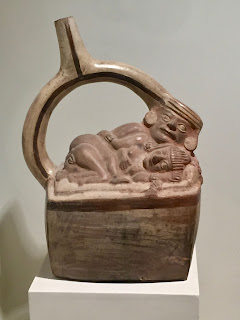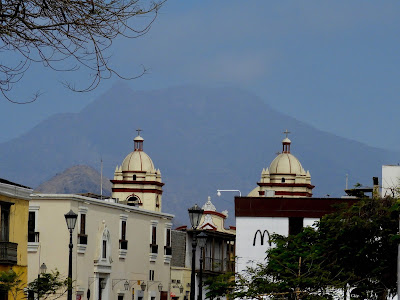We moved on to Chiclayo, on the northern coast of Peru to explore pre-Incan culture. Inca culture likely began in the 1100’s with the Incas ruling from 1438 until they were conquered by the Spanish in 1530's. The Moche (or Mochica) Culture predated them ruling from 100 - 700 AD. The Chimú followed the Moche. Both the Moche & the Chimú lived in the area north of Lima.
Since a picture is worth a 1000 words, here's the overview of some of the cultures in Peru along with the time periods. (Note: dC = despues Christo. You may think of this as AD). The key thing to note is that while the Incas get all the recognition, they were really the latecomers,
As we toured the area we were amazed at the number of tuk-tuks whipping around. They seem to serve as the primary taxis of the area.
The Lord of Sípan Tomb, discovered in 1987, is one of the richest finds in the world, in the league of the King Tut tomb. The raiders who discovered the tomb were discovered by the authorities with some of the remaining goods in their possession. Since then 15 more tombs (some with an amazing amount of gold and silver wares) have been unearthed and there have to be more because there are significant spans of years for which they have not found the royal remains. One of the earliest tombs dates from 250AD.
Some of the opulent treasures found with one skeleton were:
- an enormous headdress made of a sheet of gold 0.6m thick
- three exquisite sets of gold earrings inlaid with turquoise (about 3-4 inches in diameter mounted of posts about 3/4" to 1” in diameter
- two necklaces each with ten oversized sized peanuts – ten made of gold and ten made of silver
- a warrior’s"coxal-protector" (butt shield) made of pure gold weighing almost 1kg
- pectoral (breast) shields made of thousands of pieces of shell, bone, stone, gold and silver
- several intricately woven blankets adorned with ornate, gilded, copper pieces
- a golden sceptre, roughly 2 feet long with an inverted pyramid head about 5” on each side maybe 8” high.
- thin, totally impractical copper sandals with no wear which is taken to mean he did not need to walk anywhere
His tomb contained a total of 451 ceremonial utensils and offerings in gold, silver, copper, textile and feather intended to accompany or protect him in the afterlife.
The "Museum of the Royal Tombs of Sípan" is very modern and very well laid out. Of course, once again, no photos allowed. We really think Peru is missing the point. If folks could take photos of their treasures and share them with others, Peru would get a lot of free marketing. Of course in order to achieve their tourism potential, they would also need to build significant infrastructure. This area of Peru has very few hotels.
 |
| The two of us in front of the museum |
We browsed the web a bit and found the following which might give you a feel of the wealth buried away in this area. This gold spider "bead" is probably 3" in diameter and is one of 10 on a necklace found with "The Lord of Sípan".
For more photos checkout:
http://www.go2peru.com/peru_guide/chiclayo/photo_tombs_sipan_1.htm
The images really don't do justice to the treasure so review the list above to get a sense of the size of the pieces.
 |
| The main plaza of Chiclayo. |
|
For dinner we finally found the opportunity to go for Chifa food. Chifa cuisine combines Chinese Cantonese elements with traditional Peruvian ingredients and traditions. Its a fine combination.
We also visited the Túcume Pyramids, 26 pyramids and mounds which cover an area of over 540 acres. This site was a major regional center, maybe even the capital of the successive occupations of the area by the Lambayeque/Sican (800-1350 AD), Chimú (1350–1450 AD) and Inca (1450–1532 AD). Local shaman healers (curanderos) invoke the power of Túcume and La Raya Mountain in their rituals, and, they say that local people fear these sites.
 |
A model of some of the buildings.
For scale, note the size of the model trees on the lower left. |
 |
| View of an un-excavated mound |
 |
| A few of the ceramic artifacts on display |
 |
| We can't remember the story behind this but it might suggest why locals "fear" the site. |
While we were exploring the site we spotted some burrowing owls, and a vermillion fly-catcher...
From Chiclayo we moved south to Trujillo, the second (or third) largest city in Peru. Arequipa may be the second-largest and from the perspective of tourist infrastructure, it is far ahead of Trujillo. Since we were on the quest to experience many of the ancient cultures here, we headed to Trujillo. Along the way we visited the El Brujo Archaeological Complex. This site was occupied more or less continuously from pre-ceramic times through through colonial times. The biggest constructions here are from the Moche period and include a pyramid/Temple with the Tomb of the Lady of Cao. Given the valuables found with her, she had to be a woman of royal heritage and, quite likely, a ruler.
The pyramid has 6 or 7 layers with new layers being built over previous levels, and of course, thoroughly filling in the older layers first...which means that much of the earlier construction is preserved...but exploring them requires extremely careful excavations (or destroying the later layers). There is a great route through the pyramid leading through the various carvings on the “layers” that were built on top of each other.
Large sections of decorated walls are still preserved. Some depict ceremonies that included warriors in ceremonial battles. The winners claimed the clothes and weapons of the losers who were then, as prisoners, marched (in the nude) off to be sacrificed.
 |
| More or less life-sized images of the prisoners heading off to be sacrificed. |
 |
Walls in the area of the Lady's Tomb (probably 10 feet high).
Note: Higher levels of walls were decorated with designs, not people. |
We arrived in Trujillo mid-afternoon. After a quick visit to our room (comfy but cozy...it's in an old colonial building) we went straight to lunch in the hotel restaurant...which turned out to be very fine. In fact we enjoyed two additional lighter meals at the hotel as well: taqueños (really small, tasty empanadas) one evening and pizza for lunch (on the third day.) As you may now suspect, we found the overall restaurant scene limited, although we also enjoyed a fine meal at Cellar de Cler (ceviche caliente de lomo fino ...warm pork ceviche) and some pastas.
 |
Conchas acevichadas a la parmesana / Scallops ceviche with parmesean
Excellent. |
 |
Bomba cítrica / chocolate sphere stuffed with lemon cream, citrus truffles and passion fruit mouse
(served with a hot sauce poured over the top melting the sphere) |
 |
The Cathedral in Trujillo. The main plaza seems lovely but it is under renovation,
we were sorry to miss it |
There are still many colonial buildings in Trujillo, most are owned by banks. Some are now galleries, others are museums. Nothing spectacular, but interesting.
The next day we were off to see the Temples of the Sun and the Moon (Huaca del Sol and Huaca de la Luna). The Temples were built by the Moche. At 1,250 feet, the Sun Temple is the tallest adobe pyramid in the Americas and one of the largest in the world. The Temple of the Moon, is thought to be a former religious complex and has extremely well preserved murals. Excavations have also uncovered a large numbers of exquisite ceramics and metalworks. Interestingly enough, the Temple of the Moon is decorated very much the same as the Temple with the Lady of Cao Tomb, with the same images of warriors and prisoners and similar geometric designs.
 |
| The Temple of the Sun has not be excavated except by the Spanish who re-routed a nearby stream to help them loot the site. |
 |
| On the lower level are the warrior winners carrying the clothes and weapons of the losers |
 |
| Here we are providing a scale for the size of the area. |
Then on to Chan Chan, the capital of Peru's largest pre-Incan empire, Chimú (between the Moche & the Inca). This kingdom once stretched over 800 miles, reaching all the way to present-day Lima. (For perspective on this, it is an hours flight to Lina from Trujillo.) It is the largest adobe city in the world, covering roughly 5000 acres. We focused on the main temple which has to be 5-10 acres in size. Some of the work has been reconstructed but there is still a lot of original work as well.
 |
| This stretch of wall represents mythical under water sea creatures (the straight lines being waves.) |
 |
| There are many walls decorated with diamonds, representing fish netting. |
Our day tour ended with a visit to the beach town of Huanchaco. Fishermen here craft distinctive reed rafts called caballitos de tortora, a tradition that has spanned over 2,000 years.
 |
| Fisherman returning with his catch. The paddle is a huge piece of bamboo. |
 |
| Optimistic pelicans hoping to snag part of the fisherman's catch |
Lunch was at a nearby restaurant. Seabass ceviche (shared), grilled seabass for Pat, and seabass with garlic sauce for Bill.
On our final day on the north coast, we explored colonial Trujillo... The cathedral is decorated in a style that is simple but a bit grandiose. Note the scene from the Sistine Chapel on the ceiling...
This red & white church is pretty eye-catching.
The Archaeology Museum had some fine works from the area.
And we liked this scene...3 domes, with a mountain in the background. Knowing how the ancient cultures of Peru revere their mountains, we think they would approved of the McDonalds' logo in the foreground.
This shows a traditional part of the Colonial architecture. The balcony allows observing others without being observed in return.
Next: Back to Lima.






































































